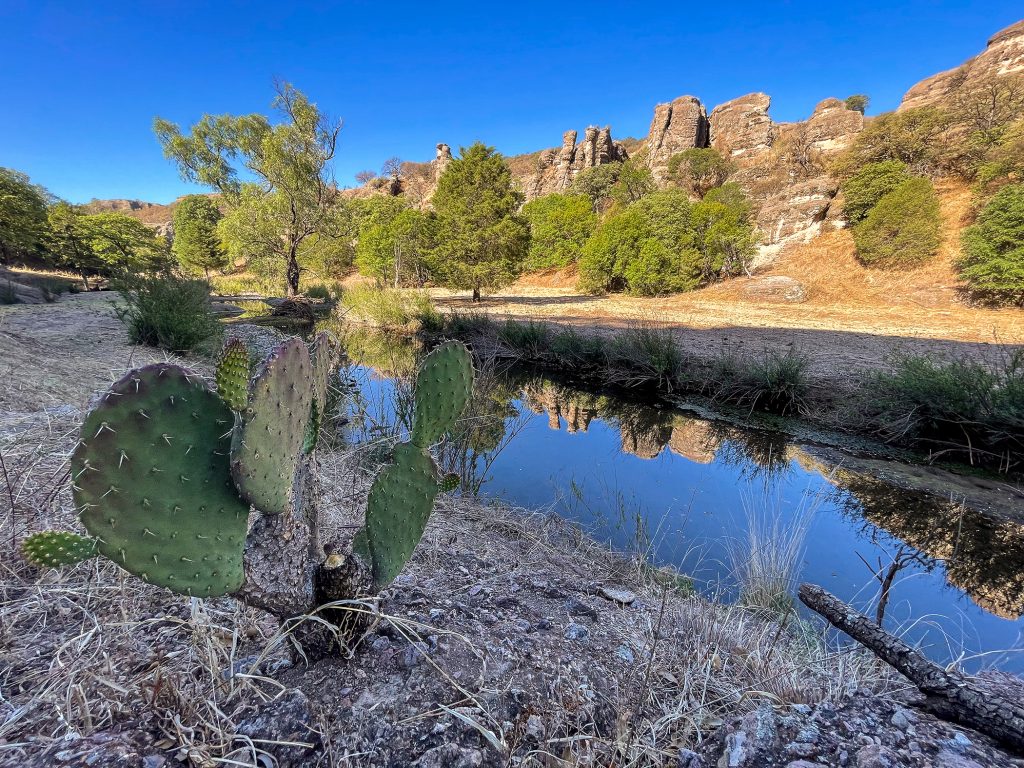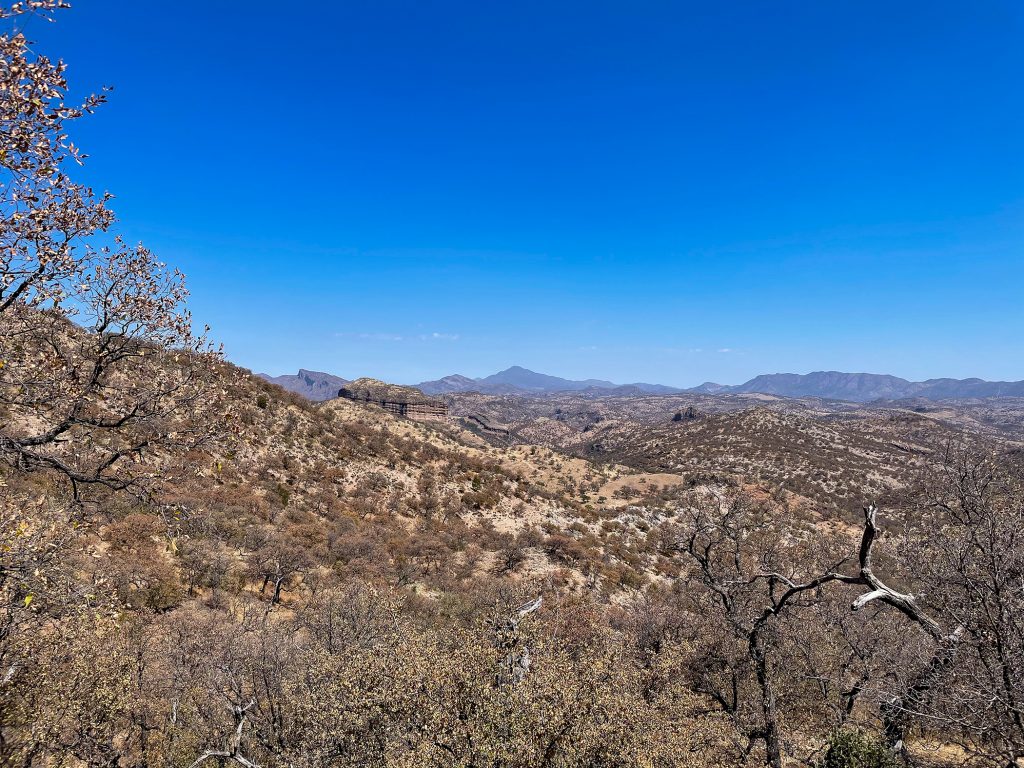The Gould’s Experience
Striking birds, stunning habitat and rich culture highlighted a turkey hunting trip of a lifetime in Mexico.
Less than an hour into the hunt, a distant gobble resonated along the ridge. Thirty minutes later, the bird gobbled again, this time a bit closer.
The tom moved slowly and talked little. I gave a few more yelps on a diaphragm call. Nothing. Then, several minutes later, I glimpsed my first Gould’s turkey in Mexico. It came in silently, catching me by surprise, like many elk I’ve called in.
The lone gobbler was in a compact strut as it moved through the pine forest, seemingly on wheels. Shafts of light from a setting sun illuminated the brilliant bird between shadows. It was stunning — more so than I’d imagined.

Finally, the gobbler strutted in, dancing pirouettes around the decoy. I hit it with sharp cutting, and it broke strut and lifted its head. The shot was simple. I’d just completed my World Slam.
It was the first afternoon of our hunt, and I was in Mexico thanks to good friend Parrey Cremeans, owner of justforhunting.com, who’d arranged our trip. He’s one of the most passionate turkey hunters I’ve met, and we’ve shared many hunts through the years. This wasn’t Cremeans’ first time hunting Gould’s in Mexico. But it was his first attempt at taking the World Slam in one season, and this would be the final bird he needed to do so.

A Slam Achieved
I shot my Gould’s the first afternoon of our arrival. We’d landed in Hermosillo, in Sonora, Mexico, that morning and had driven five hours east to the little logging town of Yécora, which served as our home base for the hunt. The outfitter had a house for us to stay in. Cremeans arranged for the transport as part of the package. The road was winding and long, and we climbed to 7,500 feet in the Sierra Madres.
The next morning, I tagged along on Cremeans’ quest for a gobbler. Birds were quiet, but we kept searching. Martin, the local guide, was getting frustrated at the lack of action, so we walked, drove and walked some more. Every ridge we topped, Martin used his box call to send loud yelps echoing into the valleys below. Finally, at about 11 a.m., we got a gobble.
The tom wasn’t budging, so we hiked to it. When we caught a glimpse of the gobbler through thick brush, it was strutting in front of five hens. Martin and Cremeans crawled ahead, set up and called. Ten minutes later, Cremeans had his single-season World Slam. It was an honor to be a part of it.
Temperatures were hot, into the upper 80s by noon. The land was dry, vast and rocky. Pine trees dominated the ridge tops, and oaks thrived below. It was beautiful and unique — nothing like any turkey habitat I’d hunted before.
Further Success
When we returned to camp, we found the third member of our party, Ted Lidie, smiling. Lidie, like Cremeans, is from Redding, California. They’re longtime friends. As with Cremeans, Lidie was in search of his single-season World Slam, but he was going for a double — two gobblers of all subspecies in one season. He’d just taken his first Gould’s and needed one more.
“Toms were everywhere,” Lidie said with a smile. “There must have been 20 on the roost, and they all came to the decoy. It was awesome.”
What’s more awesome is Lidie’s story. He’s lifetime military, was a paratrooper and served many missions throughout the world. He also recruited special forces personnel. His stories are spell-binding. After retiring from the military, Lidie started a firearms instruction company, which has grown to one of the biggest and most successful in the country. Lidie and Cremeans are active in their local NWTF chapter, serving many youth hunters and more every year. The duo has hunted most of their World Slam subspecies together.
“Getting one bird is pretty straightforward, but getting two of each subspecies can be a challenge,” Cremeans said. “On our Merriam’s hunt in Idaho, I got my bird quickly, but Ted had to go back, alone. He did it, but it took time and a lot of work.”
That afternoon, each of us having secured a bird, we relaxed in camp. With two more days, we were in no rush. I was done, and so was Cremeans — or so I thought. The more we talked that night, the more excited everyone became, and Cremeans decided to hunt for another gobbler. He got it two days later. Lidie completed his single-season double World Slam with a lone tom that came in through a dry creek bed in the bottom of a steep canyon.
The Road Home
The gobblers, in their ivory-fringed feathered armor, were more striking than I imagined, and getting them home was simple. The outfitter skinned the birds in camp and froze them, and supplied us with the necessary paperwork to present to authorities when leaving Mexico. He also supplied us with a U.S. Customs importation permit. Upon landing in the United States, we cleared customs, gathered our gear and presented the paperwork and the bird skins to authorities. They checked them through in minutes, and the next day, the birds were at the taxidermist.
The hunt, the people and the unique beauty of this special place will forever be remembered by each of us.
Taking Your Turkey Gun to Mexico
When traveling to Mexico with your shotgun, you must complete U.S. Form 4457, which is a certification of registration for personal effects taken abroad. You must have this form to present to U.S. Customs when returning to the United States with your firearm from Mexico. This form must be obtained in person from the nearest U.S. Customs and Border Protection Office, which is usually located near a large airport in your state. Plan ahead, as it can be a lengthy process of driving and waiting, and you will need to take your shotgun with you to get it properly registered.
Editor’s note: For signed copies of Scott Haugen’s popular book, Western Turkey Hunting: Strategies For All Levels, visit www.scotthaugen.com. Follow Scott on Instagram and Facebook.
